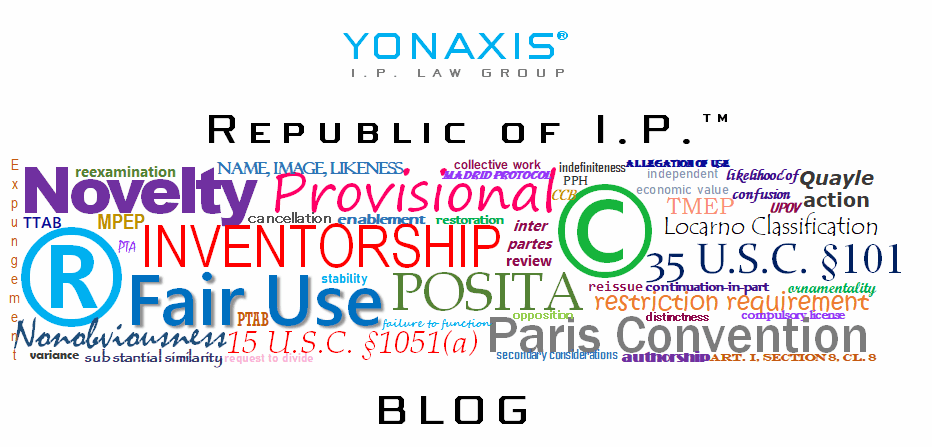U.S. Patent No. D858,154 S (‘154) issued on September 3, 2019, for “Stocking Holder.” It was issued to inventor/applicant Brad Michael Bourgoyne of Baton Rouge, Louisiana. The assignee is Fig & Dove, Inc. of Baton Rouge, Louisiana. This patent is a design patent under 35 U.S.C. §171, which protects the ornamental features of an article …
Category: patent
SCOTUS Watch: High Court Strikes Down USPTO Attorney’s Fees
On December 11, 2019, the U.S. Supreme Court affirmed the Court of Appeals for the Federal Circuit’s en banc ruling in Peter v. NantKwest, Inc.,[1] holding that the USPTO was not entitled to attorney’s fees under the 35 U.S.C. §145. Our discussion of the Fed Circuit’s en banc opinion, affirmed by the Supreme Court, was …
U.S. Patent No. PP30,860 P3
U.S. Patent No. PP30,860 P3 (‘860) issued on September 3, 2019, for “Hybrid Tea Rose Plant Named ‘MEITHATIE’.” It was issued to inventor Alain A. Meilland of Antibes, France. The applicant/assignee is The Conard-Pyle Company of West Grove, Pennsylvania. The Conard-Pyle Co. is the famous 164-year old horticulture company that focuses on roses, perennials, and …
U.S. Patent No. 10,336,597 B2
U.S. Patent No. 10,336,597 B2 (‘597) issued on July 2, 2019, for “Capsule-Based Alcoholic Beverage Apparatus and Components Thereof.” It was issued to inventors Ross Franklin of Rancho Cucamonga, California, Ed Rosenthal of Oakland, California, and Rachel Franklin of Rancho Cucamonga, California. The applicant is ERS Holdings, LLC of Piedmont, California, and the assignee is …
U.S. Patent No. 10,363,772 B2 – Thanksgiving Edition
U.S. Patent No. 10,363,772 B2 (‘772), issued on July 30, 2019, for “Turkey Fan Favorite.” The inventor is Charles D. Brown of Rydal, Georgia. The ‘772 specification describes an invention which allows for displaying device of a recently-harvested turkey for photograph by the hunting party without the need to hold the turkey in place while …
TechPat: U.S. Patent No. 10,241,896 B2
The DreamForce 2019 conference will be held in San Francisco from November 19-22, 2019. To commemorate DreamForce, the blog will highlight a recently-issued Salesforce, Inc. patent. U.S. Patent No. 10,241,896 B2 (‘896), issued on March 26, 2019, for “Formation and Manipulation of Test Data in a Database System.” The inventor is Jameison Bear Martin of …
Prosecution History Estoppel Limits Design Patent Amendments
A fascinating ruling dealing with design patents, amendments made during prosecution, and limitations on claim scope was handed down by the Court of Appeals for the Federal Circuit on September 12, 2019 in Curver Luxembourg, Sarl v. Home Expressions Inc..[1] Curver is an important piece in an otherwise scant design patent case law. Curver Luxembourg …
CannabIP: U.S. Patent No. 10,376,551 B2
U.S. Patent No. 10,376,551 B2 (‘551) issued on August 13, 2019, for “Method for Conducing Concentrated Cannabis Oil to be Stable, Emulsifiable and Flavorlesss for Use in Hot Beverages and Resulting Powderized Cannabis Oil.” It was issued to inventors Ross Franklin of Rancho Cucamonga, California, Ed Rosenthal of Oakland, California, and Rachel Franklin of Rancho …
U.S. Patent No. 10,346,782 B2
U.S. Patent No. 10,346,782 B2 (‘782), issued on July 9, 2019, for “Adaptive Augmented Decision Engine.” The inventor is Steven C. Tiell of San Francisco, California. The applicant and assignee is Accenture Global Solutions Ltd. of Dublin, Ireland. The claims are directed to the computer-implemented method of utilizing artificial intelligence for adaptive decision-making, or reduced …
Limitations on State Sovereign Immunity on Venue
The issue of sovereign immunity has been raised several times in recent memory at the Court of Appeals for the Federal Circuit, including St. Regis Mohawk Tribe v. Mylan Pharms., Inc.,[1] (discussed on the blog here), and Regents of the Univ. of Minn. v. LSI Corp.,[2] (discussed here). Board of Regents of the Univ. of …
